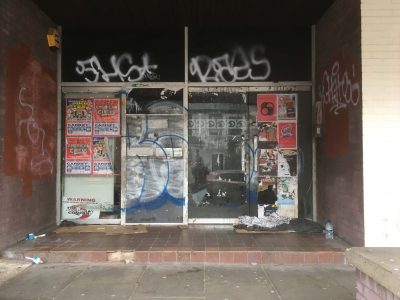
This little alien seems quite down to Earth about empty buildings © Oliver Cuenca
As homelessness and available housing shrinks, can we afford to waste such a vital resource?
On a large, empty building at the end of Canton’s Cowbridge Road, somebody has stuck a little green man. A little alien asking the question many must ask when they see this massive, empty, ice cream coloured monolith.
“What on Earth are they doing allowing people to live and die on the street when buildings like this are sitting bloody empty?”
It’s a pertinent question, especially since Wales Online recently reported a 68% rise in homelessness in the past two years.
There are at least 216, 000 homes in England and Wales that have been sitting empty for at least six months. This is according to research released in 2018 by the Liberal Democrats,
Some of these having been left by their owners for more than a decade.
Cardiff, by no means Wales’ worst offender for leaving houses empty, is no exception to this trend.
There are 1, 431 homes that have been left unoccupied in the Cardiff area for at least six months. Often abandoned in liveable conditions, yet slowly allowed to deteriorate.
And Cardiff Council states that there are currently 664 households who are deemed homeless currently on the waiting list for social housing.
Put in perspective, there are currently more than twice as many houses which are currently ‘long term’ empty as are needed to fully accommodate all of Cardiff’s homeless households.
A waste of resources
Empty houses are a waste of resources, especiallt when many now declare that there is a ‘housing crisis’.
In March, Prime Minister Theresa May declared her intention to address the lack of available housing in the UK.
“In much of the country,” she said, “housing is so unaffordable that people are struggling even to find somewhere to rent.
“If you’re not lucky enough to have support, the door to home ownership is all too often locked and barred.”
Whilst it is comforting to know that the powers that be are aware of the problem, policy by the UK government has largely been focused on increasing the construction of new build properties.
Prime Minister made a call for “more homes built more quickly,” as a solution.
This policy was echoed on the 6 December, when the Welsh Conservatives pledged to double current housing construction should they win the next Welsh Assembly election.
New houses before old ones?
Yet such new developments ignore the potential of the city’s underused housing. They are also frequently environmentally damaging, with many being built on greenfield sites.
The St Edyern’s Village is one such development. Located near the picturesque village of Old St Mellons, it is a new construction of over 1000 homes. When it was initially proposed, Persimmon Homes regional land director Andrew Crompton said that St Edyern’s was intended “to meet the demand for more family housing in the capital city of Cardiff”.
Yet this entire development would only accommodate roughly two thirds of the number of households which the 1431 long-term empty homes are capable of accommodating.
Other similar developments are planned or in progress across Wales, including the Plasdwr Garden City “set in 900 acres of countryside” northwest of Cardiff.
It is still far more time-consuming and more costly construct new houses than to bring pre-existing houses currently in limbo back onto the market.
Not only must houses be built, but in new developments, appropriate infrastructure must be too. Roads, pipes, schools and shops must follow to make sure that the new community is not cut off.
For those who are in urgent need of permanent housing, new houses may not come soon enough.
Any solutions?
But what can be done to bring these empty houses back to life?
There are many reasons why homes may be unoccupied. Inheritance disputes, complicated repossessions, or a lack of funds for landlords to refurbish a property to livable standards.
Local councils primarily aim to work with landlords to overcome these problems. They are however hesitant to force them to rent or sell their property before they are ready.

With so many people homeless, can we let buildings stay empty?
The Welsh Government’s Houses into Homes scheme provides interest-free loans to aid those who cannot afford to make property they own inhabitable, in order to bring homes back into use for sale or rent.
However, in more severe or long term cases, councils have powers to push landlords to act.
Since 2017, councils have been able to charge up to 200% on council tax for any property left permanently unoccupied for at over a year. 900 empty properties in Cardiff currently qualify for this, according to Stats Wales.
Furthermore, since 2006 local councils have been able to create Empty Dwelling Management Orders. These allow them to take control of a property which has been left empty for up to two years.
However, EDMOs are seen as extremely heavy-handed. They have rarely been used nationally since their inception, being seen as a last resort.
Due to the reluctance of local councils to interfere in issues surrounding private property, and the Welsh and British governments’ preference to build new properties over refurbishing old ones, it will be a slow process before empty properties in Cardiff are occupied again.
For that little alien on the Cowbridge Road, there may be no easy answer to his question. And there may be a long road before his grievances are resolved.
